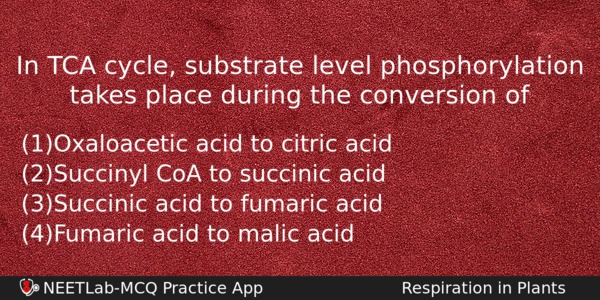| ⇦ | 
| ⇨ |
In TCA cycle, substrate level phosphorylation takes place during the conversion of
Options
(a) Oxaloacetic acid to citric acid
(b) Succinyl CoA to succinic acid
(c) Succinic acid to fumaric acid
(d) Fumaric acid to malic acid
Correct Answer:
Succinyl CoA to succinic acid
Explanation:
Succinyl-CoA is acted upon by enzyme succinyl CoA synthetase thiokinase to form succinate (a 4 carbon component). The reaction releases sufficient energy to form ATP (in plants) or GTP (in animals). GTP can form ATP through a coupled reaction.
Related Questions: - The crops engineered for glyphosate are resistant/tolerant to :
- Enzyme that changes glucose to ethyl alcohol is
- SO₂ pollution affects
- The enzyme used in the beverage industry to flavour soft drinks and in the baking
- The unit of natural selection is
Topics: Respiration in Plants
(184)
Subject: Biology
(4253)
Important MCQs Based on Medical Entrance Examinations To Improve Your NEET Score
- The crops engineered for glyphosate are resistant/tolerant to :
- Enzyme that changes glucose to ethyl alcohol is
- SO₂ pollution affects
- The enzyme used in the beverage industry to flavour soft drinks and in the baking
- The unit of natural selection is
Topics: Respiration in Plants (184)
Subject: Biology (4253)
Important MCQs Based on Medical Entrance Examinations To Improve Your NEET Score
18000+ students are using NEETLab to improve their score. What about you?
Solve Previous Year MCQs, Mock Tests, Topicwise Practice Tests, Identify Weak Topics, Formula Flash cards and much more is available in NEETLab Android App to improve your NEET score.
Share this page with your friends

Leave a Reply